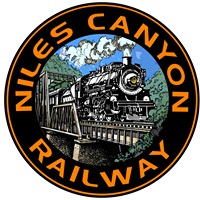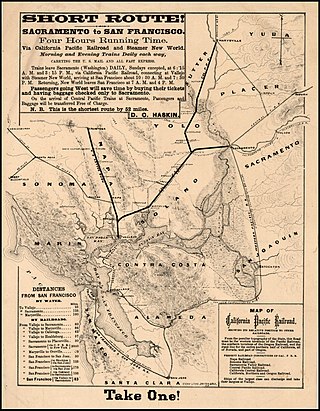
The Central Pacific Railroad (CPRR) was a rail company chartered by U.S. Congress in 1862 to build a railroad eastwards from Sacramento, California, to complete most of the western part of the "First transcontinental railroad" in North America. Incorporated in 1861, CPRR ceased independent operations in 1875 when the railroad was leased to the Southern Pacific Railroad. Its assets were formally merged into Southern Pacific in 1959.

Theodore Dehone Judah was an American civil engineer who was a central figure in the original promotion, establishment, and design of the First transcontinental railroad. He found investors for what became the Central Pacific Railroad (CPRR). As chief engineer, he performed much of the route survey work to determine the best alignment for the railroad over the Sierra Nevada, which was completed six years after his death.

America's first transcontinental railroad was a 1,911-mile (3,075 km) continuous railroad line built between 1863 and 1869 that connected the existing eastern U.S. rail network at Council Bluffs, Iowa, with the Pacific coast at the Oakland Long Wharf on San Francisco Bay. The rail line was built by three private companies over public lands provided by extensive U.S. land grants. Building was financed by both state and U.S. government subsidy bonds as well as by company-issued mortgage bonds. The Western Pacific Railroad Company built 132 miles (212 km) of track from the road's western terminus at Alameda/Oakland to Sacramento, California. The Central Pacific Railroad Company of California (CPRR) constructed 690 miles (1,110 km) east from Sacramento to Promontory Summit, Utah Territory. The Union Pacific Railroad (UPRR) built 1,085 miles (1,746 km) from the road's eastern terminus at the Missouri River settlements of Council Bluffs and Omaha, Nebraska, westward to Promontory Summit.

Lincoln is a city in Placer County, California, United States, part of the Sacramento metropolitan area. Located ten miles north of Roseville in an area of rapid suburban development, it grew 282 percent between 2000 and 2010, making it the fastest-growing city over 10,000 people in the U.S. Its 2019 population was estimated to be 48,275.

The golden spike is the ceremonial 17.6-karat gold final spike driven by Leland Stanford to join the rails of the first transcontinental railroad across the United States connecting the Central Pacific Railroad from Sacramento and the Union Pacific Railroad from Omaha on May 10, 1869, at Promontory Summit, Utah Territory. The term last spike has been used to refer to one driven at the usually ceremonial completion of any new railroad construction projects, particularly those in which construction is undertaken from two disparate origins towards a common meeting point. The spike is now displayed in the Cantor Arts Center at Stanford University.

The Sacramento Valley is the area of the Central Valley of the U.S. state of California that lies north of the Sacramento–San Joaquin River Delta and is drained by the Sacramento River. It encompasses all or parts of ten Northern California counties. Although many areas of the Sacramento Valley are rural, it contains several urban areas, including the state capital, Sacramento. Since 2010, statewide droughts in California have further strained both the Sacramento Valley's and the Sacramento metropolitan region's water security.

A frog war occurs when one private railway company attempts to cross the tracks of another, and this results in hostilities between the two railways. It is named after the frog, the piece of track that allows the two tracks to join or cross and is usually part of a level junction or railroad switch.

Niles Canyon is a canyon in the San Francisco Bay Area formed by Alameda Creek, known for its heritage railroad and silent movie history. The canyon is largely in an unincorporated area of Alameda County, while the western portion of the canyon lies within the city limits of Fremont and Union City. The stretch of State Route 84 known as Niles Canyon Road traverses the length of the canyon from the Niles district of Fremont to the unincorporated town of Sunol. Two railroads also follow the same route down the canyon from Sunol to Niles: the old Southern Pacific track along the north side, now the Niles Canyon Railway, and the newer Union Pacific track a little to the south. At the west end of the canyon are the ruins of the Vallejo Flour Mill, which dates to 1853.

Alameda Terminal was a railroad station and ferry wharf at the foot and west of present-day Pacific Avenue and Main Street in Alameda, California, on the eastern shore of San Francisco Bay with ferry service to San Francisco. It was built in 1864 and operated by the San Francisco and Alameda Railroad. In 1869, it served as the original west coast terminus of the U.S. First transcontinental railroad, until the opening of Oakland Pier two months later. The western terminus was inaugurated September 6, 1869, when the first Western Pacific through train from Sacramento reached the shores of San Francisco Bay at Alameda Terminal, — thus completing the first transcontinental railroad "from the Missouri river to the Pacific ocean" in accordance with the Pacific Railroad Acts.

The first Vallejo Flour Mill, in the Niles district of Fremont, California, was built in 1841 by José de Jesús Vallejo (1798–1882), elder brother of General Mariano Guadalupe Vallejo, on his Rancho Arroyo de la Alameda, along with a dam and aqueduct to power it. The Flour Mill was located at the mouth of Niles Canyon, then called Alameda Cañon, which served as the major course of Alameda Creek. A second Flour Mill was built in 1856, the stone foundation of which may still be seen today.

The Niles Canyon Railway (NCRy) is a heritage railway running on the first transcontinental railroad alignment through Niles Canyon, between Sunol and the Niles district of Fremont in the East Bay of the San Francisco Bay Area, in California, United States. The railway is listed on the National Register of Historic Places as the Niles Canyon Transcontinental Railroad Historic District. The railroad is operated and maintained by the Pacific Locomotive Association which preserves, restores and operates historic railroad equipment. The NCRy features public excursions with both steam and diesel locomotives along a well-preserved portion of the first transcontinental railroad.
Addison Cook Niles was an attorney and served as Nevada County judge in California from 1862–1871 and as associate justice on the Supreme Court of California from 1872–1880.

The California Pacific Railroad Company was incorporated in 1865 at San Francisco, California as the California Pacific Rail Road Company. It was renamed the California Pacific Railroad Extension Company in the spring of 1869, then renamed the California Pacific Railroad later that same year. Its main line from Vallejo to Sacramento was completed six months prior to the May 1869 golden spike ceremony of the Central Pacific/Union Pacific Transcontinental Railway.

The San Francisco and San Jose Railroad (SF&SJ) was a railroad which linked the communities of San Francisco and San Jose, California, running the length of the San Francisco Peninsula. The company incorporated in 1860 and was one of the first railroads to employ Chinese laborers in its construction. It opened the first portion of its route in 1863, completing the entire 49.5-mile (80 km) route in 1864. The company was consolidated with the Southern Pacific Railroad in 1870. Today, Caltrain and the Union Pacific Railroad continue to operate trains over part of the company's original route.
The Sacramento Valley Railroad (SVRR) was incorporated on August 4, 1852, the first transit railroad company incorporated in California. Construction did not begin until February 1855 because of financial and right of way issues, and its first train operated on February 22, 1856. Although the oldest working railroad in the state was the Arcata and Mad River Railroad, first operational in December 15, 1854, the Sacramento Valley Railroad was the West's pioneering incorporated railroad, forerunner to the Central Pacific.

The Solano was a large railroad ferry, built as a reinforced paddle steamer with independently powered sidewheels by the Central Pacific Railroad, that carried entire trains across the Carquinez Strait between Benicia and Port Costa in California daily for 51 years, from 1879 to 1930. When launched, the Solano was the largest ferry of its kind in the world, a record held for 35 years until 1914 when she was joined by her sister ship, the Contra Costa, which was 13 feet (4.0 m) longer.
The San Francisco and Alameda Railroad (SF&A) was a short-lived railroad company in the East Bay area of the San Francisco Bay Area. The railroad line opened 1864–1865 from Alameda Terminal on Alameda Island to Hayward, California, with ferry service between Alameda Terminal and San Francisco started in 1864. After being bankrupted by the 1868 Hayward earthquake, it was acquired by a subsidiary of the Central Pacific Railroad in August 1869. Part of the SF&A line between Alameda Terminal and San Leandro served as a portion of the First transcontinental railroad starting in September 1869, while the southern section was abandoned in 1873.
The Western Pacific Railroad (1862–1870) was formed in 1862 to build a railroad from Sacramento, California, to the San Francisco Bay, the westernmost portion of the First transcontinental railroad. After the completion of the railroad from Sacramento to Alameda Terminal on September 6, 1869, and then the Oakland Pier on November 8, 1869, which was the Pacific coast terminus of the transcontinental railroad, the Western Pacific Railroad was absorbed in 1870 into the Central Pacific Railroad.

Maine Prairie is an unincorporated community located in Solano County, California east of Elmira, California on the Maine Prairie Slough at latitude 38.308 and longitude -121.759. The elevation is 7 feet (2.1 m). Maine Prairie appears on the Dozier U.S. Geological Survey Map.

The California Steam Navigation Company was formed in 1854 to consolidate competing steamship companies in the San Francisco Bay Area and on the Sacramento and San Joaquin Rivers. It was successful in this effort and established a profitable near-monopoly which it maintained by buying out or bankrupting new competitors. In response to the Fraser Canyon gold rush and economic growth in the Pacific Northwest, the company expanded to ocean routes from San Francisco north to British Columbia. Similarly, as California's economy grew, the company offered service from San Francisco south to San Pedro and San Diego. It exited these markets in 1867 when competition drove prices to unprofitable levels. While the California Steam Navigation Company was successful throughout its life in suppressing steamboat competition on its core Bay Area and river routes, it could not control the rise of railroads. These new competitors reduced the company's revenue and profit. Finally, in 1871, the company's assets were purchased by the California Pacific Railroad, and the corporation was dissolved.




















